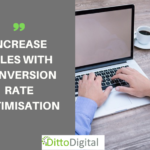In the vast and dynamic realm of digital marketing, a successful online presence is defined not only by driving traffic but also by converting that traffic into paying customers or loyal users. In this brief Introduction to Conversion Rate Optimisation (CRO) we look at the craft of enhancing the user experience, fine-tuning your website, and streamlining your digital marketing efforts to achieve a higher conversion rate. This comprehensive guide explores the intricate world of CRO, offering insights, strategies, and best practices for maximizing your online success.
Understanding Conversion Rate Optimisation
1. Defining Conversion Rate Optimisation
Conversion Rate Optimisation, often abbreviated as CRO, is the systematic process of improving a website or digital platform to encourage users to take a desired action. This action could be making a purchase, signing up for a newsletter, filling out a contact form, or any other activity that aligns with your business goals. CRO is both an art and a science, incorporating elements of psychology, design, data analysis, and marketing to enhance the user experience and drive results.
2. The Importance of CRO
Why is CRO important? In a world where digital competition is fierce and users have countless choices, a high conversion rate can be the difference between business success and failure. By optimising your conversion rate, you can:
- Increase Revenue: A higher conversion rate directly translates to more sales or leads, boosting your revenue.
- Maximise Marketing ROI: Instead of investing in increasing traffic, you can improve the efficiency of your existing traffic.
- Improve User Experience: CRO efforts often lead to a more user-friendly website, enhancing user satisfaction.
- Understand Your Audience: Through CRO, you gain valuable insights into user behaviour and preferences.
The CRO Process
1. Setting Clear Goals
The first step in CRO is defining your goals. What do you want users to do on your website? Whether it’s completing a purchase, filling out a form, or downloading an e-book, your goals should be specific, measurable, and aligned with your overall business objectives.
2. Analysing User Behaviour
To optimise conversions, it’s crucial to understand how users interact with your website. Web analytics tools, such as Google Analytics, can help you track user journeys, identify drop-off points, and pinpoint areas for improvement.
3. A/B Testing
A/B testing, or split testing, is a fundamental CRO technique. It involves creating two or more versions of a webpage, each with a distinct element you want to test (e.g., headline, call-to-action button, wording, positioning of elements, colours). By comparing the performance of these variations, you can determine which elements have the most significant impact on conversions.
4. Enhancing User Experience
A positive user experience is key to boosting conversions. This involves optimising page load times, simplifying navigation, improving mobile responsiveness, and ensuring clear, persuasive content.
5. Leveraging Social Proof
Social proof, such as customer reviews, testimonials, and trust badges, can significantly influence users’ decisions. Integrating these elements into your website can build trust and encourage conversions.
6. Crafting Effective Call-to-Actions (CTAs)
The language, design, and placement of CTAs are critical. A compelling CTA should be clear, action-oriented, and strategically located on your webpage to guide users toward your goal.
Key Metrics in CRO
1. Conversion Rate
The conversion rate is the percentage of users who take the desired action on your website. It’s a fundamental metric for CRO and helps you track the effectiveness of your optimisation efforts.
2. Engagement Rate
Engagement Rate is the metric used in Google Analytics 4 (GA4) as a measure of how much users engaged with the content on a website: did they spend time reading it or click on a link, button or other CTA on the page, for instance. It is (very roughly) the inverse of the bounce rate metric familiar in digital marketing prior to the migration from Google’s old Universal Analytics to the new GA4 in July 2023. A low engagement rate suggests that users aren’t finding what they expected or that your content doesn’t meet their needs.
3. Click-Through Rate (CTR)
CTR measures the effectiveness of your CTAs or links. It’s relevant for email marketing campaigns pay-per-click (PPC) advertising, and organic search as it reflects how many users are clicking through to your landing pages from emails, search ads or organic search listings respectively.
4. Average Session Duration
This metric indicates how long users spend on your website. A longer average session duration is generally positive, as it suggests user engagement and interest.
5. Exit Rate
The exit rate shows the percentage of users who leave your site from a specific page. By analysing exit rates, you can identify pages that need further optimisation.
Testing and Iteration
CRO is an ongoing process of testing, analysing, and iterating. What works today may not work tomorrow due to evolving user preferences or market trends. Regularly test new strategies, gather data, and refine your approach to continue improving your conversion rate.
Final Thoughts
We have only given a very brief introduction to Conversion Rate Optimisation here, but when used effectively CRO is an invaluable tool for businesses seeking to thrive in the digital landscape. By understanding user behaviour, setting clear goals, and implementing testing and optimisation strategies, you can transform your website into a powerful conversion machine. CRO is not just about increasing numbers; it’s about enhancing the user experience and driving your business toward greater success. Invest in a digital marketing strategy that involves Content Marketing, SEO and CRO, and watch your digital efforts flourish.





Some very useful tips. Would your recommend starting CRO at the same time as an SEO project or wait until there is some good organic traffic?
For CRO to be effective you do need to have a reasonable amount of data otherwise the test results are meaningless, and can even suggest a particular element of a web page has better engagement than others because the dataset is too small. For a website that has never had any search optimisation implemented I would get that done first and once the traffic starts to flow you can start on some simple CRO. Usually we perform CRO on mature sites that are already well-optimised, but would also do so on newer sites with a lot of traffic (several thousand visits/m as a very rough guide)